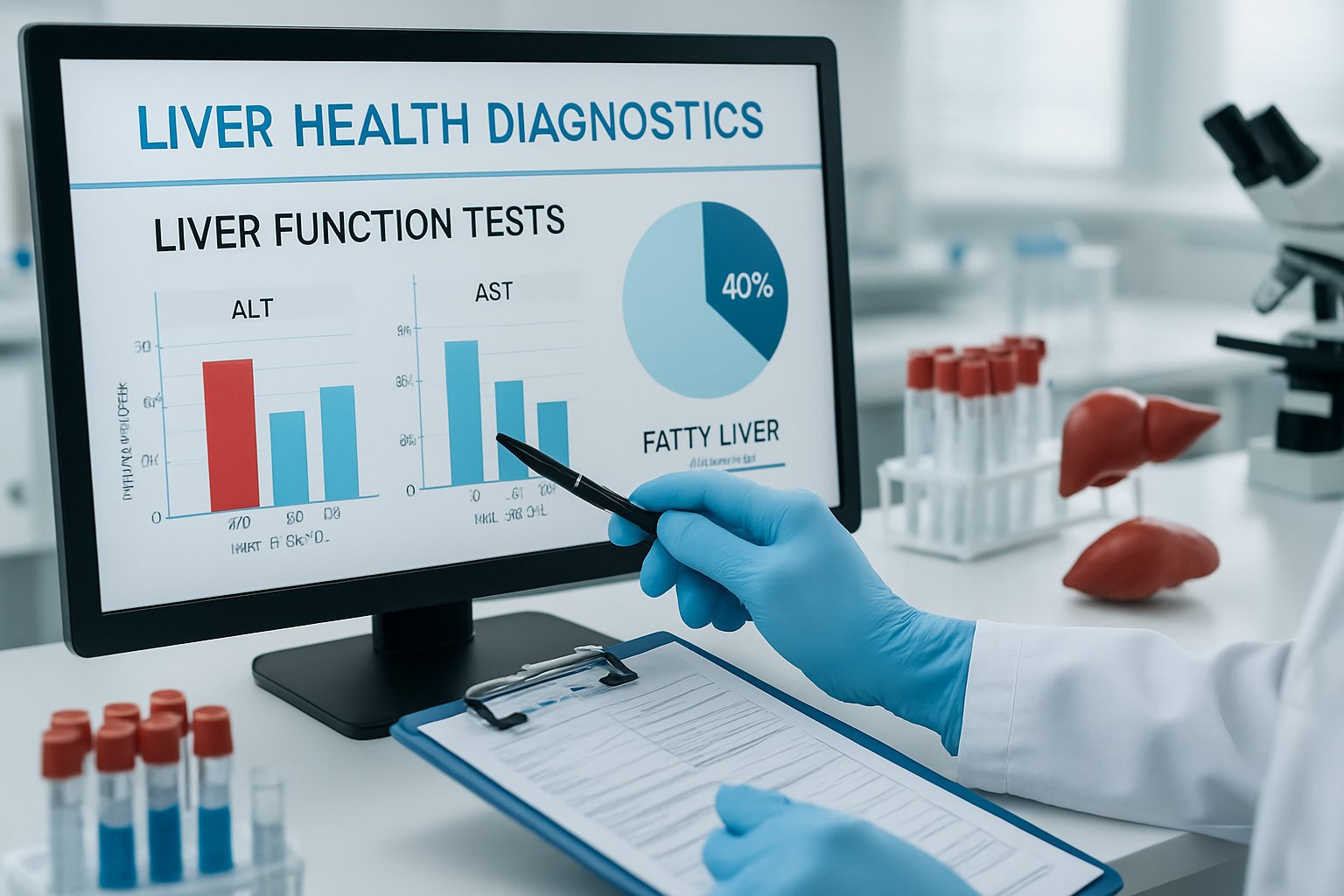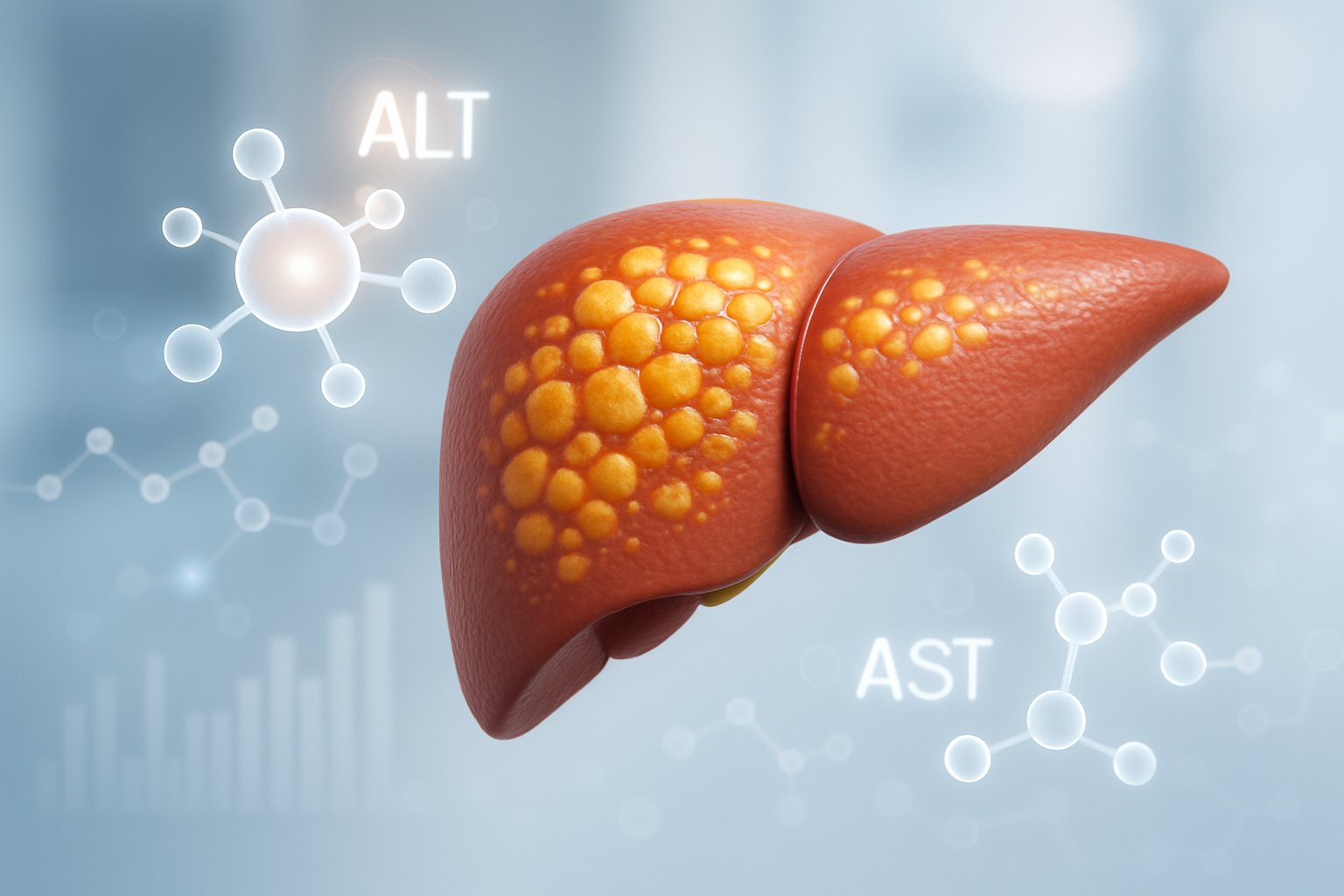ALT levels are typically higher than AST levels in fatty liver disease, creating a ratio below 1. This enzyme pattern helps doctors identify fatty liver and distinguish it from other liver conditions. Understanding your liver enzyme ratios can guide treatment decisions and help monitor your liver health.
If you’ve been diagnosed with fatty liver disease, you might wonder about your liver enzyme test results and what they mean for your health. The relationship between ALT and AST levels can provide important clues about the type and severity of liver problems you may be experiencing.

In fatty liver disease, ALT levels are typically higher than AST levels, creating an AST/ALT ratio of less than 1. This pattern helps doctors distinguish fatty liver from other liver conditions like alcoholic liver disease or cirrhosis, where the ratio would be different. An AST/ALT ratio of less than 1 is a general indication of fatty liver disease[1].
Understanding these enzyme patterns can help you make sense of your lab results and work with your doctor to manage your condition effectively. The specific numbers and ratios tell a story about what’s happening inside your liver and guide treatment decisions.
ALT and AST Levels in Fatty Liver

In fatty liver disease, ALT levels typically rise higher than AST levels, creating a distinctive pattern that helps doctors identify this condition. The ALT to AST ratio usually falls below 1, meaning ALT values exceed AST values in most patients with fatty liver.
Typical Enzyme Patterns in Fatty Liver
Non-alcoholic fatty liver disease shows elevated ALT levels[2] that reflect liver cell injury from fat buildup. ALT rises more significantly than AST in fatty liver patients.
The normal ALT range is typically 7-56 units per liter for men and 7-40 units per liter for women. In fatty liver disease, ALT can increase to 2-5 times the normal range.
AST levels also increase but remain lower than ALT in most cases. This creates the characteristic pattern where ALT dominates the enzyme elevation.
Common enzyme ranges in fatty liver:
- ALT: 80-200 units per liter
- AST: 60-150 units per liter
- ALT/AST ratio: Less than 1
The degree of elevation often matches the severity of fat accumulation in liver cells.
Significance of Elevated ALT Compared to AST
ALT elevation carries more significance in fatty liver because this enzyme exists mainly in liver cells. When fat builds up in the liver, it damages these cells and releases ALT into the bloodstream.
AST appears in multiple organs including the heart, muscles, and kidneys. This makes AST less specific for liver problems compared to ALT.
An AST/ALT ratio of less than 1 indicates fatty liver disease[1] when ALT levels exceed AST levels. This pattern helps doctors distinguish fatty liver from other liver conditions.
The ALT-predominant pattern suggests the liver damage comes from metabolic factors rather than alcohol or viral infections. This distinction guides treatment decisions and helps predict disease progression.
Clinical Implications of the ALT to AST Ratio
The ALT to AST ratio provides crucial diagnostic information for fatty liver patients. Ratios below 1 strongly suggest non-alcoholic fatty liver disease rather than alcohol-related liver damage.
Ratios less than 1 typically indicate non-alcoholic causes[3] like viral hepatitis or drug-induced injury. This helps doctors focus on metabolic causes of liver disease.
When the ratio reverses and AST becomes higher than ALT, it may signal disease progression. Advanced fatty liver disease or cirrhosis can shift this pattern.
Ratio interpretations:
- Less than 1: Suggests fatty liver disease
- Equal to 1: May indicate acute hepatitis
- Greater than 2: Suggests alcohol-related liver disease
Regular monitoring of this ratio helps track disease progression and treatment response.
Variations in Enzyme Patterns Among Patients
Enzyme patterns vary between patients based on disease severity and individual factors. Some patients show mild ALT elevation while others develop significantly higher levels.
Age affects enzyme patterns, with older patients sometimes showing different ratios. Gender differences also exist, as women typically have lower baseline ALT levels than men.
Patients with diabetes or obesity often display higher ALT elevations. These conditions worsen fat accumulation in liver cells, leading to greater enzyme release.
Factors affecting enzyme patterns:
- Disease duration
- Body weight
- Blood sugar control
- Other medical conditions
Some patients maintain stable enzyme levels for years, while others experience fluctuating values that require closer monitoring.
Causes and Interpretation of Liver Enzyme Elevations

Understanding what causes ALT and AST levels to rise helps doctors identify fatty liver disease and rule out other conditions. The pattern of enzyme elevation and specific ratios provide important clues for accurate diagnosis.
Factors Affecting ALT and AST Levels
Multiple factors can cause liver enzymes to rise beyond fatty liver disease. Medications, herbal supplements, alcohol use, and viral hepatitis[4] are common causes that doctors must consider.
Medication-Related Causes:
- Pain relievers like acetaminophen
- Antibiotics and antifungal drugs
- Anti-inflammatory medications (NSAIDs)
- Prescription medications for chronic conditions
Alcohol consumption significantly affects enzyme patterns. Even moderate drinking can elevate AST more than ALT, creating a different ratio pattern than fatty liver disease.
Non-Liver Related Factors:
- Intense physical exercise
- Muscle injury or breakdown
- Heart problems
- Thyroid disorders
Age and gender also influence normal enzyme ranges. Men typically have slightly higher baseline levels than women. Pregnancy can cause temporary elevations that resolve after delivery.
Recent illness, surgery, or medical procedures may temporarily raise enzyme levels. Doctors often retest after several weeks to see if levels return to normal.
How Enzyme Levels Guide Fatty Liver Diagnosis
The ALT to AST ratio serves as a key diagnostic tool for fatty liver disease. In NAFLD, elevated ALT levels particularly reflect liver cell injury due to fat accumulation[2].
Typical Fatty Liver Pattern:
- ALT higher than AST (ratio usually less than 1.5)
- ALT levels 2-5 times above normal range
- AST levels mildly to moderately elevated
Doctors use these enzyme patterns alongside other factors. Body weight, diabetes history, and imaging results help confirm the diagnosis.
Progressive Disease Indicators:
- Very high ALT levels (over 10 times normal)
- Changing ALT to AST ratio over time
- Rising enzyme levels despite lifestyle changes
The severity of enzyme elevation doesn’t always match liver damage severity. Some people with significant fat buildup have only mild enzyme increases.
Doctors track enzyme changes over months to assess disease progression. Improving levels suggest treatments are working, while worsening numbers may indicate advancing liver damage.
Other Conditions With Similar Enzyme Changes
Several liver conditions can mimic the enzyme pattern seen in fatty liver disease. Distinguishing between these conditions requires additional testing and clinical evaluation.
Viral Hepatitis: Hepatitis B and C can cause ALT-predominant elevations similar to fatty liver. Blood tests for viral markers help differentiate between these conditions.
Autoimmune Liver Disease: These conditions often cause high ALT levels with specific antibody markers. Additional blood tests can identify autoimmune causes.
Drug-Induced Liver Injury: Many medications cause ALT elevations that look identical to fatty liver patterns. Drug-induced liver reactions are a frequent cause of acute liver issues[2].
Wilson’s Disease and Hemochromatosis: These genetic conditions affect young adults and can cause enzyme patterns similar to fatty liver. Specialized tests measure copper and iron levels.
Doctors use patient history, physical examination, and additional blood tests to narrow down the cause. The timeline of enzyme elevation often provides important clues about the underlying condition.
Frequently Asked Questions
The AST to ALT ratio provides crucial diagnostic information for fatty liver disease, with specific patterns indicating different liver conditions. Understanding normal enzyme ranges and monitoring guidelines helps doctors make accurate diagnoses and treatment decisions.
What is the significance of the AST/ALT ratio in the diagnosis of fatty liver disease?
The AST/ALT ratio helps doctors distinguish between different types of liver disease. In fatty liver disease, ALT levels are typically higher than AST levels, creating a ratio less than 1.
This pattern occurs because ALT is more concentrated in liver cells than AST. When fatty liver causes cell damage, more ALT gets released into the blood compared to AST.
An AST-to-ALT ratio greater than 2:1 strongly suggests alcohol-related liver disease[3]. Non-alcoholic fatty liver disease usually shows the opposite pattern with ALT being higher.
How can AST and ALT levels be interpreted in the context of fatty liver?
In fatty liver disease, ALT levels often rise first and stay higher than AST levels. This creates a characteristic pattern that helps doctors identify the condition.
The degree of elevation can indicate how severe the fatty liver disease has become. Mild fatty liver may cause small increases in ALT, while more advanced disease causes larger jumps.
Both enzymes may increase together, but ALT typically shows a greater rise. This happens because liver cells contain more ALT than AST, making it a more sensitive marker for fatty liver damage.
What does an AST/ALT ratio greater than 1 indicate in liver function tests?
An AST/ALT ratio greater than 1 suggests the AST level is higher than the ALT level. This pattern can indicate several different liver conditions depending on how much higher AST is compared to ALT.
When the ratio is slightly above 1, it may suggest advancing liver disease or muscle damage. AST exists in both liver cells and muscle cells, so muscle injury can raise the ratio.
Elevated AST greater than ALT can also appear in cirrhosis from any cause[4]. The ratio becomes more pronounced as liver disease progresses to more severe stages.
What are the normal ranges for AST and ALT in liver health assessments?
Normal ranges typically fall between 4-36 IU/L for ALT and 5-30 IU/L for AST[3]. These ranges can vary slightly between different laboratories and testing methods.
Age, gender, and body weight can affect what doctors consider normal ranges for each person. Men often have slightly higher normal ranges than women for both enzymes.
The specific upper limit varies, but most labs use similar cutoff points. Values above these ranges suggest possible liver cell damage or inflammation.
How does fatty liver disease affect ALT levels compared to AST levels?
Fatty liver disease typically causes ALT levels to rise more than AST levels. This happens because liver cells contain higher concentrations of ALT enzyme compared to AST.
The possible causes of high ALT levels in the body include liver disease, alcoholism, obesity, muscle damage, heart failure, and more[5]. In fatty liver specifically, the ALT elevation often relates to obesity and metabolic factors.
As fatty liver progresses, both enzymes may increase. However, ALT usually remains the dominant elevated enzyme until the disease reaches advanced stages like cirrhosis.
Why is monitoring AST and ALT levels important for children with liver conditions?
Children with suspected liver problems need regular enzyme monitoring because their normal ranges differ from adults. Early detection helps prevent serious complications as they grow.
Fatty liver disease is becoming more common in children due to rising obesity rates. Regular AST and ALT testing helps doctors catch the condition before it causes permanent damage.
Children process medications differently than adults, making enzyme monitoring essential during treatment. Some medications can affect liver enzymes, and regular testing helps ensure treatments remain safe.
References
- An AST/ALT ratio of less than 1 is a general indication of fatty liver disease. https://www.verywellhealth.com/liver-enzymes-1759916 Accessed October 27, 2025
- Interpreting Liver Enzyme Tests: ALT, AST, and ALP in Liver Health Monitoring. https://www.rupahealth.com/post/interpreting-liver-enzyme-tests-alt-ast-and-alp-in-liver-health-monitoring Accessed October 27, 2025
- How to Read Liver Function Tests. https://resources.walkinlab.com/liver-health/how-to-read-liver-function-tests/ Accessed October 27, 2025
- How to approach elevated liver enzymes?. https://www.aasld.org/liver-fellow-network/core-series/back-basics/how-approach-elevated-liver-enzymes Accessed October 27, 2025
- High ALT Blood Test Levels: Causes, Symptoms and When to Worry. https://www.medicinenet.com/what_does_it_mean_when_you_have_high_alt/article.htm Accessed October 27, 2025
